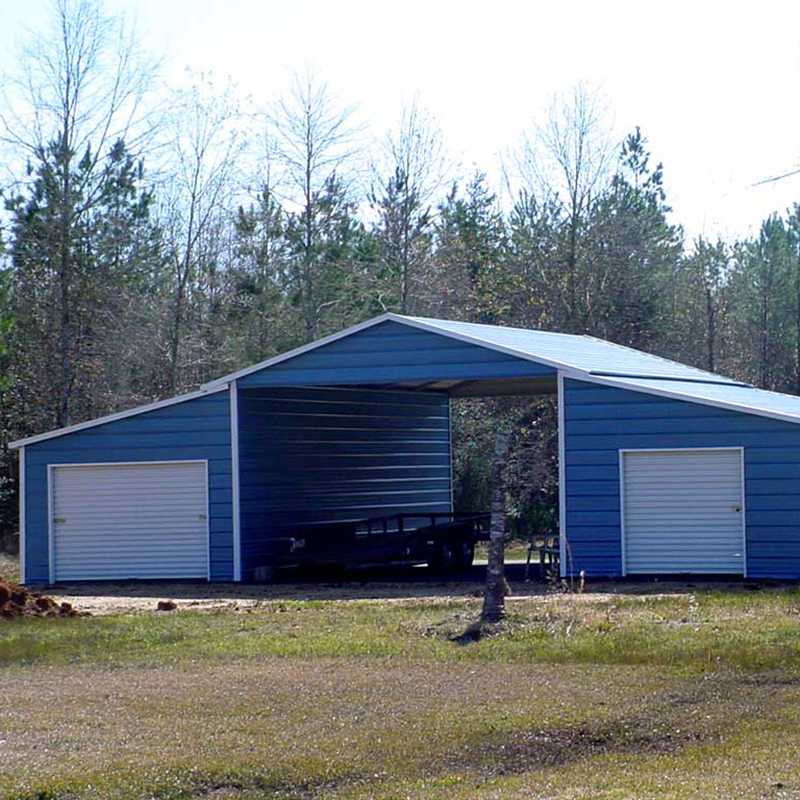At present, steel structure has been widely used in factory buildings.The main components of steel structure workshop are welding H-shaped steel column, beam and brace.If the welding deformation is not corrected, it will not only affect the overall installation of the structure, but also reduce the safety and reliability of the project.If the deformation of welded steel structure exceeds the allowable deformation range of technical design, it should be corrected to meet the product quality requirements.
The correction methods widely used in the production process include mechanical correction, flame correction and comprehensive correction.However, flame correction is a difficult work to operate. Improper control of methods and temperature will cause new and greater deformation of components.Therefore, flame correction should have rich practical experience.
1 Types of welding deformation of steel structure and flame correction
The main components of steel structure are welded H-shaped steel column, beam and brace.The following three flame correction methods are often used for welding deformation:
(1) Linear heating method;
(2) Point heating method;
(3) Triangle heating method.
The following describes the construction methods to solve different parts.
The following is the heating temperature for flame correction (made of mild steel)
Note: the heating temperature should not be too high when flame correction, too high will cause metal embrittlement and affect impact toughness.16Mn should not be cooled with water during high temperature correction, including steel with larger thickness or hardening tendency.
1.1Angular deformation of flange plate
Correct the deformation of H-shaped steel column, beam and brace angle.
On the flange plate (outside the alignment weld), longitudinal linear heating (heating temperature should be controlled below 650 ℃), and the heating range should not exceed the control range of two welding legs, so water cooling is not required.
Attention should be paid to the following when heating in linear form:
(1) It should not be heated repeatedly in the same position;
(2) Do not water during heating.These two points are the general principle of flame correction.
1.2 Arch, deflection and bending of column, beam and brace
1、 On the flange plate, the bending deformation can be corrected by heating the longitudinal weld from the middle to both ends.In order to avoid bending and twisting deformation, the two heating belts should be carried out simultaneously.Low temperature correction or medium temperature correction can be adopted.This method is beneficial to reduce the welding internal stress, but it is difficult to master because of the longitudinal shrinkage and lateral shrinkage.
2、 Linear heating is applied to the flange plate and triangle heating is applied to the web plate.
This method is used to correct the bending deformation of columns, beams and braces. The transverse linear heating width is generally 20-90mm. When the plate thickness is small, the heating width should be narrower, and the heating process should be extended from the middle of the width to both sides.
The linear heating should be carried out by two persons at the same time, and then heated separately. The width of triangle should not be more than 2 times of the thickness of the plate, and the bottom of the triangle should be equal to the width of the corresponding wing plate.
The heating triangle starts at the top, then extends from the center to both sides, and heats layer by layer until the bottom of the triangle.When heating the web, the temperature should not be too high, otherwise it will cause depression and deformation, which is difficult to repair.
Note: the above triangular heating method is also applicable to side bending correction of components.During heating, the medium temperature correction should be adopted and the watering should be less.
1.3 Wave deformation of column, beam and brace webs
In order to correct the wave deformation, we should first find out the convex wave crest, and then use the dot heating method and the hammer to correct it.
The diameter of the heating spot is generally 50-90mm. When the thickness of the steel plate or the wavy area is large, the diameter should also be enlarged. The heating value can be calculated as d = (4 δ + 10) mm (D is the diameter of hot spot; δ is the thickness of the plate).
The toasting mouth moves spirally from the wave crest and is corrected at medium temperature.
When the temperature reaches 600 ~ 700 ℃, put the hand hammer on the edge of the heating zone, and then hit the hammer with a sledgehammer, so that the metal in the heating zone is extruded, cooled and compressed, and then flattened.
Excessive shrinkage stress should be avoided during correction.After a circle point is straightened, the second wave peak point is heated. The method is the same as above.In order to speed up the cooling rate, Q235 steel can be cooled with water.The distribution of heating points can be in the form of plum blossom or chain dense point.Pay attention not to exceed 750 ℃.
2 epilogue
The stress caused by flame correction is the same as that of welding.The superposition of internal stress caused by improper correction, welding internal stress and load stress will make the longitudinal stress of column, beam and brace exceed the allowable stress, which will lead to the reduction of bearing safety factor.Therefore, in the steel structure manufacturing, we must be careful, try to use reasonable process measures to reduce deformation, and try to use mechanical correction.When flame correction has to be adopted, the following points should be paid attention to:
(1) The location of the fire should not be near the maximum stress section of the main beam;
(2) The heating area of the correction site should not be too large in one section, and several more sections should be selected;
(3) The point heating method should be used to improve the stress state of the heating zone;
(4) The heating temperature should not exceed 700 degrees
Post time: Jul-10-2020

